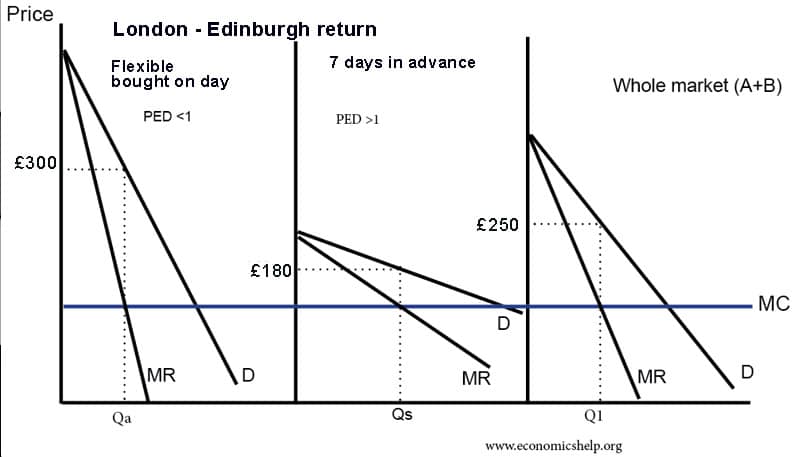Third Degree Price Discrimination involves charging a different price to different groups of consumers for the same good. These groups of consumers can be identified by particular characteristics such as age, sex, location, time of use.
In the real world, third-degree price discrimination is quite common. For a firm to practise price discrimination it requires:
- Ability to set prices. Some market power.
- Ability to segment different classes of consumers (e.g. rail card to prove you are a senior citizen)
- Ability to prevent resale. E.g. stop adults using student tickets.
Direct price discrimination
Third degree price-discrimination is sometimes known as direct price discrimination. Because a firm directly sets different prices depending on distinct groups of consumers (e.g. age)
The alternative is indirect price discrimination where consumers can choose depending on their behaviour, e.g. bulk buying gets lower average cost.
Price discrimination for train tickets
If you buy on the day, tickets are usually more expensive. If you book 7 days in advance and stick to a specific time of the day, the price is lower.
On the same train, customers can be paying different prices for the same ticket.
Examples of Third Degree Price Discrimination

- Students frequently get a 10% discount in shops and restaurants
- Pensioners get discounted bus and train tickets. up to 33% cheaper
- Book in advance. If you book train tickets in advance, usually they are much cheaper than buying on the day. This is because customers who buy in advance are usually more price sensitive. They have time to look for alternatives. Businessmen who buy on the day, probably have higher income, but also consider train journey more of a necessity – therefore, their demand is price inelastic.
- A nightclub may offer a discount to female consumers on certain nights.
Logic of Third Degree Price Discrimination
Why are students given 10% discount?
With lower-income, students tend to be more sensitive to prices. Their demand is price elastic. Therefore, by cutting prices for students, a firm is able to increase sales and revenue, but still, keep relatively higher prices for other adults who have more inelastic demand.
Different forms of price discrimination – product versioning
Note: A variance of price discrimination occurs when firms sell slightly different products. For example, first-class tickets are more expensive because the firm can offer a better service. However, first-class tickets also take advantage of different elasticities of demand. Businessmen who pay first class will have a more inelastic demand and so willing to pay higher prices to get a slightly better product.
Related

